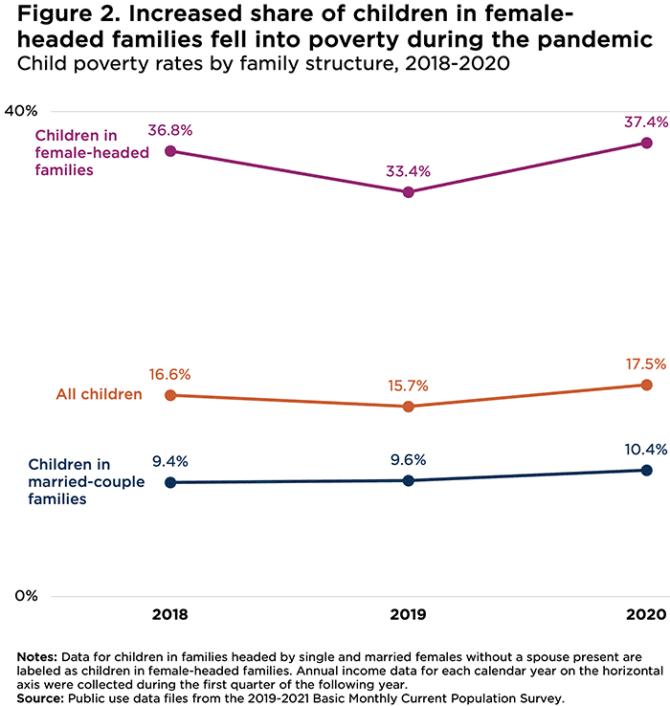Child poverty rates have increased during the COVID-19 pandemic, particularly among Latino and Black children and among children in female-headed families, according to a new Child Trends analysis of recently released national data from the Current Population Survey. These newly released data provide a first nationally representative look at how the pandemic has changed child poverty. We find that child poverty increased by an average of 1.8 percentage points—from 15.7 percent in 2019 to 17.5 percent in 2020—based on families’ reports in 2020 and 2021. This translates to roughly 12.5 million children living in poverty in 2020, or 1.2 million more than in 2019.
These national estimates mask the variation in economic circumstances experienced across child subgroups: Poverty rates among Latino children rose by 4.2 percentage points, from 23.0 percent to 27.3 percent[1], and by 2.8 percentage points among Black children, from 26.4 percent to 29.2 percent (see Figure 1). This amounts to an increase of approximately 700,000 more Latino children and 268,000 more Black children living in poverty in 2020, relative to 2019. In contrast, the rates of White and Asian children in poverty remained relatively stable.[2] In addition, children in female-headed families also saw a large increase in the poverty rate, by 4.1 percentage points, from 33.4 percent to 37.4 percent[3] (see Figure 2)—a total increase of about 642,000 more children in female-headed families living in poverty. Not only do these increases reverse the downward trend in child poverty rates seen in the years leading up to the pandemic, but the pandemic also widened differences by race/ethnicity and family structure.


The economic fallout of the COVID-19 pandemic has been widespread, with many families experiencing multiple, co-occurring material and economic hardships that not only create short-term distress but also have implications for children’s longer-term well-being and development. These hardships—which include, but are not limited to, loss of jobs and wages, health problems, food insecurity, housing instability, and disruptions to child care and schooling—have disproportionately fallen on female-headed families and Latino and Black families. Additionally, Latino and Black families face structural racism and systemic barriers in education, housing, employment, health care, and wealth accumulation, making it harder for them to weather and recover from the recession.
Our estimates are based on family income in the past 12 months, as reported in answers to one question on the basic monthly Current Population Survey (CPS). Our approach (see methodology below) differs from the more robust official poverty measure, which uses data from multiple income questions; however, these data will not be available until Fall 2021. Our analysis highlights the elevated poverty rate among children, as close to real-time as possible, allowing policymakers to consider both emergency responses and longer-term policies for targeting resources, supporting families, and investing in children for our future economy—especially those children who have been harmed most by the pandemic.
Our estimates join other evidence suggesting that economic disparities have increased among children during the pandemic. Other efforts to measure poverty during the pandemic include one study that estimates annual poverty rates using CPS monthly data from the initial months of the pandemic and another that imputes monthly poverty rates, with both adjusting for major cash transfers such as stimulus checks and unemployment benefits. Our estimates, in comparison, are based on families’ reports of income from the first year of the pandemic and do not explicitly examine how government programs may have impacted child poverty.
Methodology
[1] Before rounding to the tenth decimal place, the rates of Latino child poverty in 2019 and 2020 were 23.047% and 27.283%, respectively, resulting in a difference of 4.236 percentage points.
[2] Our estimates present average poverty rates for each subgroup and may mask heterogeneity within each of these subgroups. For example, the estimate for Asian children likely masks the wide variation seen within this subgroup.
[3] Before rounding to the tenth decimal place, poverty rates among children in female-headed families in 2019 and 2020 were 33.363% and 37.426%, respectively, for a difference of about 4.063 percentage points.
© Copyright 2025 ChildTrendsPrivacy Statement
Newsletter SignupLinkedInYouTubeBlueskyInstagram
